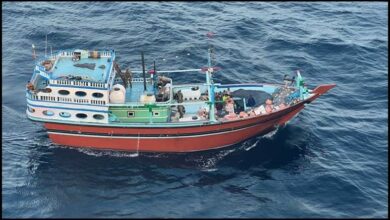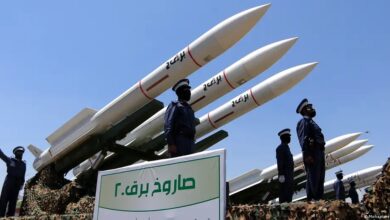Iran seizes UK-flagged Stena Impero tanker in the Strait of Hormuz
Iran’s Islamic Revolutionary Guard Corps said Friday that it has impounded a British-flagged oil tanker, the second foreign vessel seized by the Guards this week.
The IRGC said in a July 19 statement that it had “confiscated” the tanker at the request of Hormozgan Ports and Maritime Organization for an alleged “failure to observe international maritime regulations.”
Earlier on Friday, the U.K.-flagged Stena Impero changed course in the Persian Gulf, turning for the islands of Larak and Qeshm – home to an IRGC base – in the Strait of Hormuz.

The tanker’s last position was south of Larak on Friday evening, based on data from the website MarineTracker.com. It was en route to Saudi Arabia, according to the same data.
“Stena Bulk and Northern Marine Management can confirm that at approximately 1600 BST on 19th July U.K. registered vessel Stena Impero (built 2018, 49,683 DWT) was approached by unidentified small crafts and a helicopter during transit of the Strait of Hormuz while the vessel was in international waters. We are presently unable to contact the vessel which is now heading north towards Iran,” the ship’s owners said in a Friday statement.
There are 23 crew on board, the statement said.
“Northern Marine Management has not been able to establish contact directly with the vessel since it was notified of the incident at approximately 1600 Today, 19th July 2019.”
The #MarineTraffic playback shows the journey of the British Tanker #StenaImpero earlier today, right up to her last reported position before she went dark at 16:29 UTC. pic.twitter.com/Bor7jp3uRL
— MarineTraffic (@MarineTraffic) July 19, 2019
The vessel is the second foreign oil tanker seized by the Islamic Republic this week. On Thursday, the IRGC said it had impounded the Panamanian-flagged tanker Riah, on Sunday, which it accused of smuggling fuel.
The U.K. Ministry of Defence said it was “urgently seeking further information” about the tanker.
On Saturday, Reza Khaasteh, a journalist with the news website Iran Front Page, reported that the Stena Impero had been involved in a collision with an Iranian fishing boat and failed to respond to the latter’s distress signal, prompting its seizure by Iranian officials.
Allah-Morad Afifipoor, head of the Hormozgan Ports and Maritime Organization, said the tanker had “collided with a fishing boat,” and was now anchored off the port of Bandar Abbas with all 23 crew on board, AFP reported.
British-owned MV Mesdar boarded, cautioned and allowed to continue
There were reports that a second ship, the U.K.-owned and Liberian-flagged Mesdar, had veered sharply towards the Iranian coast from the Strait of Hormuz on Friday night.

U.K. foreign minister Jeremy Hunt later said that he was “extremely concerned by the seizure of two naval vessels by Iranian authorities in the Strait of Hormuz,” confirming that they were British- and Liberian-flagged vessels.
The Mesdar later turned on its transponder and resumed its course. Khaasteh reported the tanker had been “cautioned about the need for harmless navigation and observing of environmental regulations.”
The ship’s owner, Norbulk Shipping U.K., later said the ship had been boarded but was free to leave.
“Communication has been re-established with the vessel and [the captain] confirmed that the armed guards have left and the vessel is free to continue the voyage. All crew are safe and well,” the company said in a statement.
After a second meeting on Friday of COBR, the U.K.’s high-level emergency committee, a government spokesperson told the BBC that Iran’s actions “represent a clear challenge to international freedom of navigation.”
“We have advised U.K. shipping to stay out of the area for an interim period,” the spokesperson added.
US develops multinational Operation Sentinel
Early on Saturday, the U.S. military’s Central Command said in a statement it was “developing a multinational maritime effort, Operation Sentinel, to increase surveillance of and security in key waterways in the Middle East” in light of recent events in the Persian Gulf.
CENTCOM said the goal of the operation is “to promote maritime stability, ensure safe passage, and de-escalate tensions in international waters throughout the [Persian] Gulf, Strait of Hormuz, the Bab el-Mandeb Strait (BAM) and the Gulf of Oman.”
Operation Sentinel would “enable nations to provide escort to their flagged vessels while taking advantage of the cooperation of participating nations” for coordination, awareness and surveillance, noting that “contributions and leadership from regional and international partners will be required to succeed.”
Persian Gulf shipping tensions
The Strait of Hormuz, which runs between the Persian Gulf and and Gulf of Oman, is a key shipping route for international commerce.
Iran had vowed to retaliate after one of its oil tankers was seized by officials off the coast of Gibraltar on July 4, sparking a row with the United Kingdom.
A Gibraltar court on Friday extended the detention of the Grace 1 supertanker by a further 30 days.
The U.K. said last week that three boats believed to be IRGC vessels tried to stop the merchant tanker British Heritage as it was entering the Strait of Hormuz from the Gulf.
The Royal Navy has since dispatched HMS Duncan to join HMS Montrose in the Gulf, and said on Wednesday that it would send a second Type 23 frigate, the HMS Kent, to the region later this year.
On Thursday, the U.S. amphibious assault ship USS Boxer brought down an Iranian drone near the Strait of Hormuz after the unmanned aerial system “closed within a threatening range” of the ship and its crew, the Pentagon said.
In late June, the IRGC shot down a U.S. RQ-4 Global Hawk surveillance drone which it said violated Iranian airspace over the Kuh-e Mubarak region of Iran’s southern Homozgan province. The U.S. maintains the drone was operating in international airspace.
A week earlier, the Trump administration blamed the IRGC for attacks on Japanese and Norwegian fuel tankers in the Gulf of Oman, allegations that Iranian officials have denied. The Pentagon said Iran fired a surface-to-air-missile at an American drone the same day.
Washington had previously accused Iran of being behind May 12 attacks on four tankers anchored off the United Arab Emirates port of Fujairah at the entrance of the Strait of Hormuz.
Tensions between Tehran and the West have deepened since last year when President Donald Trump announced he was pulling the U.S. out of the 2015 Joint Comprehensive Plan of Action nuclear deal that was reached between China, France, Germany, Iran, Russia, the U.K. and the U.S.
Iran has since accused the Europeans of failing to live up to their end of the deal by standing up to the U.S., and has begun enriching uranium at a level higher than allowed under the agreement – so far high enough to support nuclear power plants, but still far too low to be viable in a nuclear weapon.
This story was updated on July 19 and 20, 2019 with additional developments and background.












One Comment